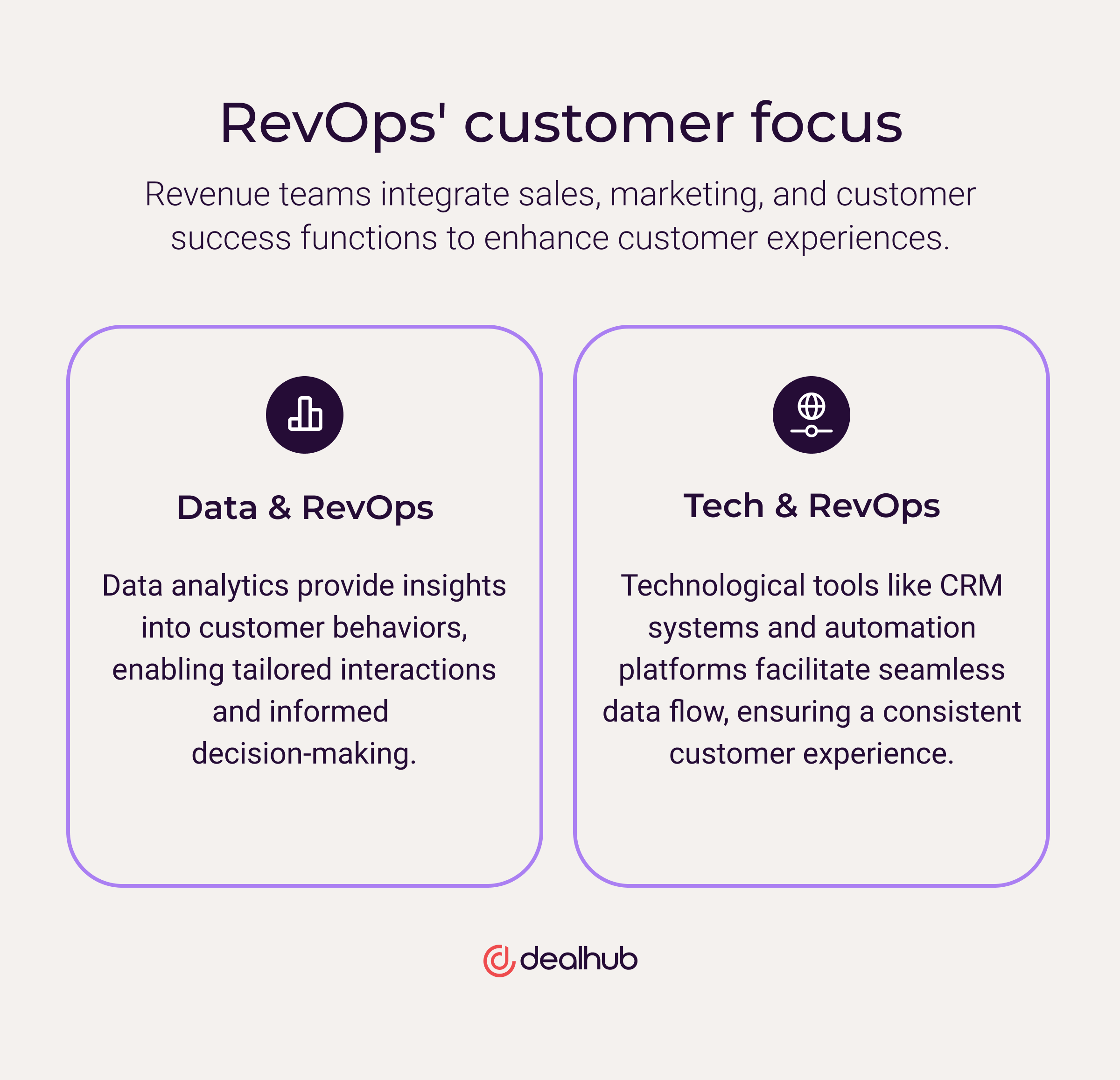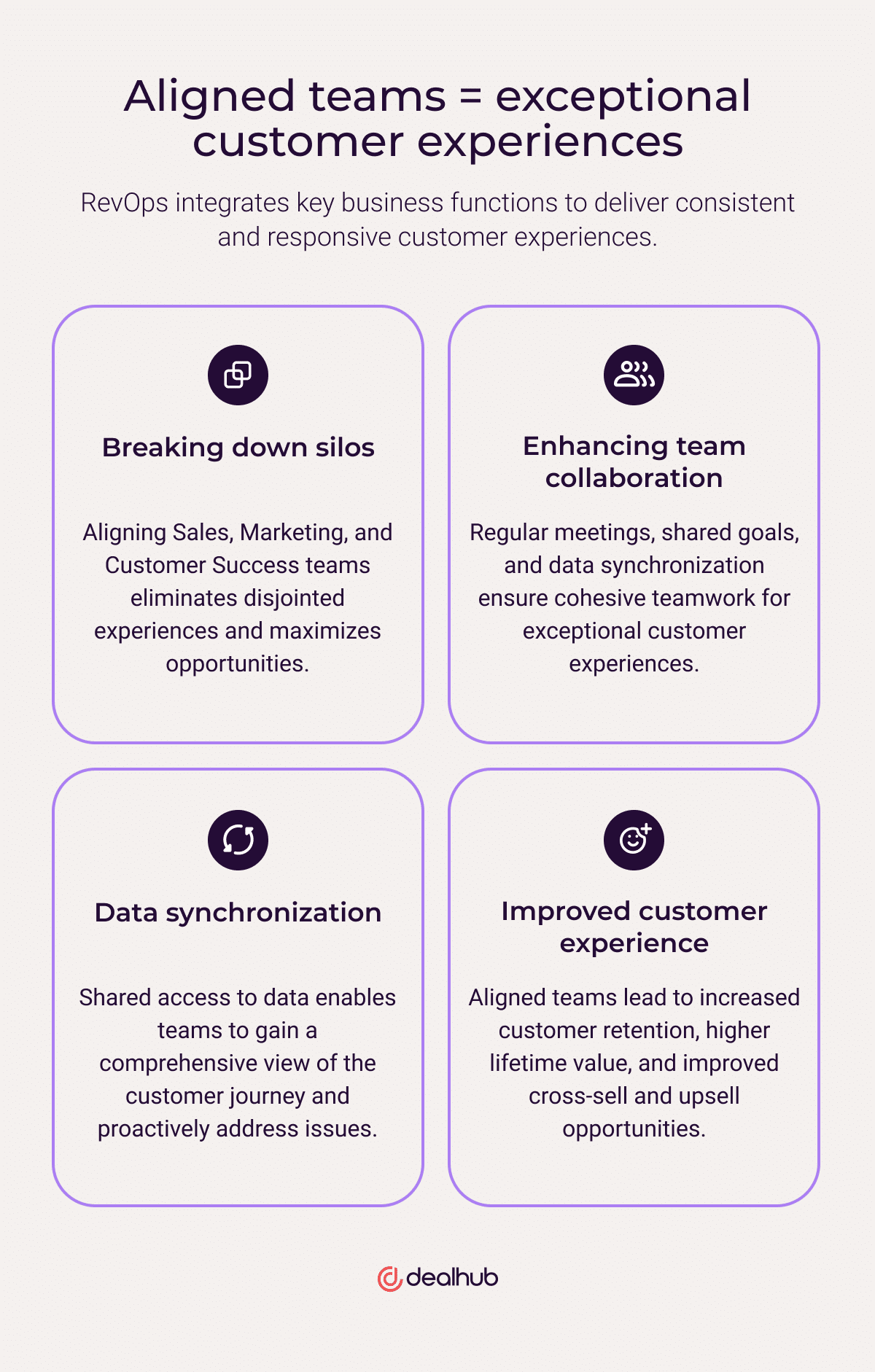A striking statistic demonstrating RevOps’ efficacy is the notable rise in its adoption. From 2018 to 2019, there was a 55% increase in RevOps adoption, reflecting its growing importance in contemporary business practices. Moreover, a recent study by the Boston Consulting Group finds that companies investing in RevOps have reported a substantial uplift in sales productivity, ranging from 10-20%. At the heart of these successes are RevOps leaders, who, through innovative strategies, ensure that customer interactions across Sales, Marketing, and Customer Success are harmonized, leading to improved customer experiences and business growth.
Below we explore how RevOps leaders are developing customer-centric strategies to drive revenue growth and what we can learn from their success.
RevOps’ customer focus

Revenue teams are characterized by their holistic integration of sales, marketing, and customer success functions, with a laser focus on enhancing customer experiences. This approach ensures a unified customer journey, where each interaction adds value and syncs with the customer’s needs.
Aligning strategies around data and technology helps RevOps leaders unify the customer experience.
Data & RevOps
Data is the lifeblood of effective RevOps strategies and helps leaders make informed decisions. Utilizing data analytics, RevOps teams can unlock insights into customer behaviors and preferences. This data-driven approach facilitates tailored customer interactions based on solid, actionable insights rather than assumptions. A case in point could be a telecom company analyzing customer usage patterns to create targeted offers, thereby increasing customer satisfaction and revenue, and reducing customer churn.
Tech & RevOps
The right technological infrastructure is imperative for successfully executing RevOps initiatives. Tools like CRM systems and marketing automation platforms enable the seamless flow of customer information across different departments, ensuring everyone can access up-to-date data. This integration is necessary for maintaining a consistent customer experience. A software company using a unified CRM system is an example of this, improving real-time customer interactions and boosting customer satisfaction scores.
Aligned teams = exceptional customer experiences

RevOps is centered on integrating key business functions, guided by data and supported by technology, to deliver a customer experience that is not only consistent but also deeply responsive to customers’ evolving needs.
Breaking down silos
The alignment of Sales, Marketing, and Customer Success teams brings numerous benefits, chiefly by breaking down the silos that traditionally exist within organizations. When these departments operate in isolation, it often leads to disjointed customer experiences and missed opportunities. For instance, Marketing might generate leads that Sales find irrelevant or Customer Service insights might not be utilized to inform product development. By breaking down these silos, businesses ensure that every department works towards a unified goal: enhancing the customer experience.
This alignment leads to a more cohesive understanding of the entire customer journey. For example, when the Sales team shares insights about customer pain points, Marketing can create more targeted campaigns, while Customer Success can tailor their support to address these specific issues. This collaborative effort results in a more streamlined and efficient approach to customer engagement, leading to higher customer satisfaction and loyalty.
Enhancing team collaboration
Enhancing communication and collaboration among Sales, Marketing, and Customer Success teams is pivotal in creating exceptional customer experiences. Regular inter-departmental meetings, shared goals and metrics, and collaborative planning sessions help ensure that all teams are on the same page and working cohesively.
Data synchronization across these departments is essential because of its strategic benefits. With shared access to data, each team can gain a comprehensive view of the customer journey, from initial contact through to post-sale support. This synchronization allows for more personalized customer interactions and enables teams to proactively address potential issues before they escalate. For example, suppose a customer expresses dissatisfaction in a sales call. In that case, this information can be immediately shared with the Customer Success team, who can then take steps to address the issue and improve the customer’s experience.
In practice, this alignment has led to remarkable improvements in customer experience. Businesses that have successfully aligned their teams often report increased customer retention, higher customer lifetime value, and improved cross-sell and upsell opportunities.
RevOps leaders drive alignment

RevOps leaders are vital in driving the alignment of Sales, Marketing, and Customer Success teams through strategic planning, judicious technology use, and meticulous success measurement.
Establishing a unified strategy
RevOps leaders face the challenge of overcoming team alignment issues and resistance to change. They focus on establishing a unified strategy that resonates across all departments to address this. This involves setting common goals that align with the overall business objectives and ensuring each team understands how their role contributes to these business goals.
One effective strategy is conducting joint planning sessions where teams can voice their concerns and contribute ideas. This inclusive approach helps mitigate resistance by involving team members in the decision-making process. Additionally, RevOps leaders can implement change management practices, offering training and support to ease the transition to new processes and systems. For example, when introducing a new CRM system, providing comprehensive training and highlighting its benefits can help in gaining team buy-in.
Leveraging technology
Technology plays an indispensable role in streamlining processes within revenue operations teams. Automation tools can enhance efficiency, reduce errors, and free up team members to focus on more strategic tasks. However, choosing the right technology stack is critical. This includes tools like Customer Relationship Management (CRM) systems, marketing automation platforms, and Configure, Price, Quote (CPQ) software. CPQ tools, for instance, can significantly streamline the sales process by automating pricing and quote generation, thereby reducing manual errors and speeding up the sales cycle. Furthermore, CPQ analytics loops sales data back to RevOps teams to improve marketing messaging, sales strategies, pricing, and customer communication.
Another crucial aspect is ensuring data consistency across departments. RevOps leaders need to guarantee that the technology stack used by different teams can seamlessly share and update data. This consistent data flow is essential for maintaining a unified view of the customer and ensuring that all teams have access to the same, up-to-date information.
Measuring RevOps success
RevOps leaders rely on specific key performance indicators (KPIs) to gauge the success of alignment efforts. These might include customer satisfaction (CSAT) scores, churn rates, and conversion rates. Monitoring these metrics helps understand alignment strategies’ impact on customer experiences and business outcomes.
RevOps leaders should also celebrate successes and learn from failures. Celebrating achievements, big or small, can boost team morale and motivate members to continue working towards common revenue goals. Equally important is learning from setbacks. By analyzing failures, leaders can identify areas for improvement and adjust strategies accordingly. This continual measurement, celebration, and learning process is vital for the ongoing success of RevOps initiatives.
Customer-first RevOps alignment
As RevOps leaders, the strategic alignment of key departments under a customer-first approach is both challenging and rewarding. It’s about harmonizing Sales, Marketing, and Customer Success, using technology wisely, and measuring success through meaningful metrics. The goal is clear: enhance customer experiences and drive sustained business success.
This approach emphasizes the importance of viewing every strategy, technological tool, and metric through the lens of customer impact. It’s about fostering a culture that prioritizes the customer, ensuring that every decision and action resonates with their needs and expectations.
Reflecting on the central themes of this article, the essence of RevOps alignment emerges as a subtle yet powerful reminder for you as a leader: to consider how each strategic decision and action across your teams can resonate positively with your customers. How can you nurture a culture that inherently values customer perspectives, ensuring every business move is a step towards meeting and exceeding customer expectations?
The answer may lie in enhancing customer feedback mechanisms, more deeply analyzing customer data, or even revisiting your team’s sales KPIs to ensure they align with customer-centric objectives. The journey toward a truly customer-first model is ongoing but yields tremendous opportunities for greater team alignment and revenue growth.




